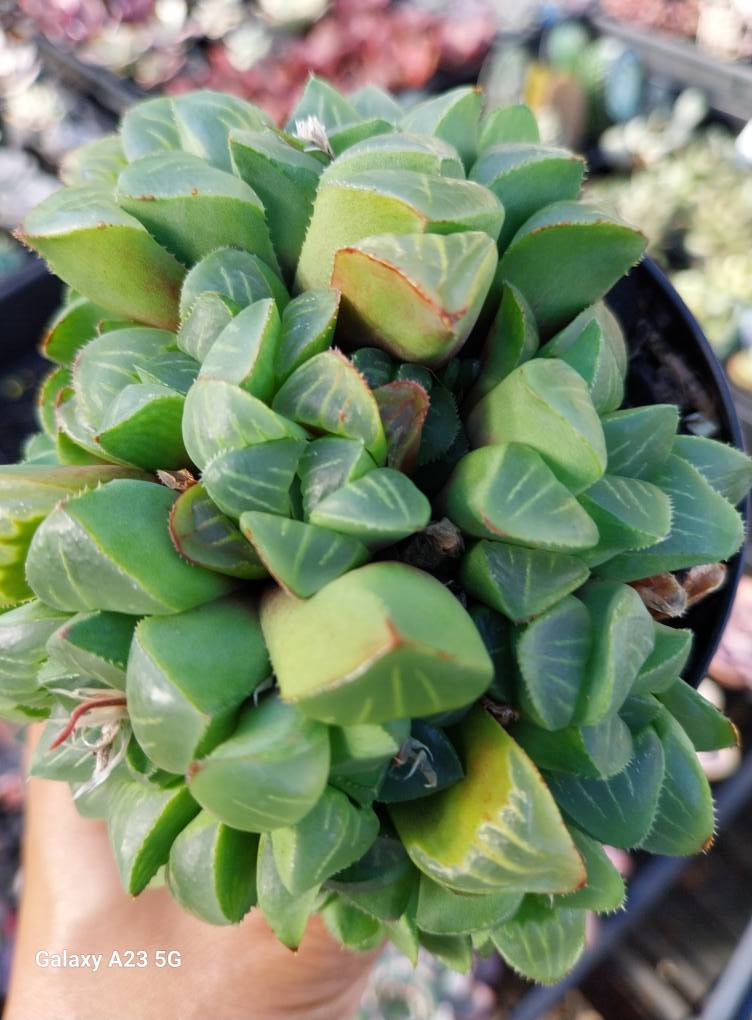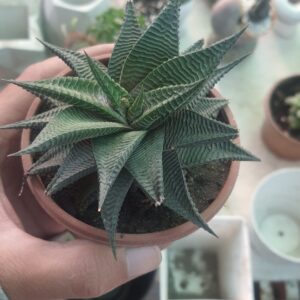🌿✨ Haworthia otzeniana — The Star-Patterned Succulent
Haworthia otzeniana is a small, elegant, and slow-growing succulent native to South Africa, belonging to the Asphodelaceae family. This species is admired for its unique, triangular, dark green leaves that form a flattened rosette, often decorated with translucent patterns or windowed tips. These “leaf windows” allow light to penetrate deeper into the plant, a fascinating adaptation to its arid, shaded natural habitat.
Its attractive form, combined with its compact size and ease of care, makes Haworthia otzeniana a favorite among succulent collectors and indoor gardeners.
🌿 Botanical Overview
Scientific Name: Haworthia otzeniana
Family: Asphodelaceae
Origin: South Africa
Growth Habit: Small, rosette-forming succulent
Size:
Height: 1.5 to 3 inches (4–8 cm)
Spread: 3 to 5 inches (7–13 cm)
USDA Hardiness Zones: 9–11
🍃 Appearance
Leaves:
Thick, fleshy, triangular leaves arranged in a flat to slightly raised rosette
Deep green to grey-green color
Decorated with translucent, window-like areas and darker mottled patterns
The leaf surface may be rough or textured
Flowers:
Small, tubular, white to pale pink flowers on a thin, tall stalk
Typically bloom in spring or summer, though not very showy
While the flowers are modest, the geometric beauty of the leaves is the main visual appeal.
☀️ Light Requirements
Indoors:
Prefers bright, indirect light
Suitable for north or east-facing windows
Can tolerate some low light but grows best with adequate brightness
Outdoors:
Thrives in partial shade to light filtered sun
Avoid direct, intense afternoon sun to prevent leaf scorch
Exposure to filtered morning sun or placement under a shade cloth outdoors will maintain healthy growth and vibrant leaf patterns.
🌡️ Temperature & Humidity
Temperature:
Ideal range: 18–27°C (65–80°F)
Protect from temperatures below 5°C (41°F) to prevent frost damage
Not frost-tolerant
Humidity:
Prefers low to moderate humidity
Excessive humidity with poor airflow may lead to fungal issues
💧 Watering Routine
Active Growing Season (Spring to Fall):
Water when the top 1–2 inches of soil are completely dry
Typically every 2 weeks, but adjust based on environmental conditions
Water thoroughly, ensuring excess water drains completely
Winter Dormancy:
Water sparingly, about once every 3–4 weeks
Reduce frequency significantly to prevent rot
🚫 Avoid letting water sit in the rosette, as this can cause crown rot.
🌱 Soil Requirements
Type:
Requires well-draining, gritty soil
Ideal mix:
50% cactus/succulent mix
25% coarse sand
25% perlite or pumice
pH: Neutral to slightly acidic (6.0–7.0)
Proper drainage is essential to prevent root rot and fungal infections.
🌾 Fertilizing
During Growing Season:
Fertilize once a month with a diluted, balanced succulent fertilizer
Example: 10-10-10 or 5-10-10 NPK at half strength
Winter:
Do not fertilize during dormancy
Over-fertilization can lead to weak, leggy growth or damage.
✂️ Maintenance and Pruning
Pruning:
Minimal pruning required
Remove dead or dried leaves at the base
Use sterilized scissors or gently pull away old leaves
Pest Control:
Occasionally affected by:
Mealybugs
Aphids
Spider mites
Inspect regularly and treat with neem oil or insecticidal soap
🌿 Propagation
Offsets (Pups):
Produces offsets or pups at the base
Allow pups to grow to a manageable size before separating
Use a sterile knife to separate pups, let them callous for 1–2 days, then plant in well-draining soil
Leaf Cuttings:
Less common, as leaf propagation is slower and less reliable in Haworthia
Seeds:
Can propagate from seeds, but it’s slow and best suited for experienced growers
Offsets are the quickest and most reliable method.
🛡️ Common Issues
Overwatering: Leads to root or crown rot
Sunburn: Leaves turn pale or scorched under direct harsh sunlight
Pest Infestation: Especially in dusty or poorly ventilated spaces
Ensure proper watering, filtered light, and good air circulation to prevent most problems.
🎍 Decorative Uses
Best For:
Succulent dish gardens
Terrariums with ventilation
Office desks or small spaces
Rock gardens under shade
Its compact size, ornamental leaf patterns, and resilience make it perfect for indoor decor and low-maintenance gardening.
✅ Conclusion
Haworthia otzeniana is a beautiful, geometric succulent ideal for both beginners and collectors. Its minimal watering needs, shade tolerance, and unique leaf textures make it an attractive, low-effort plant. With the right care, it rewards with slow but steady growth, elegant form, and occasional flowering, adding charm to any collection.





Reviews
There are no reviews yet.